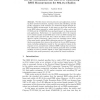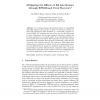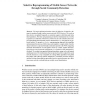EWSN
2010
Springer
14 years 5 months ago
2010
Springer
Abstract. Wireless sensor network protocols and applications, including those used for localization, topology control, link scheduling, and link quality estimation, make extensive ...
EWSN
2010
Springer
14 years 6 months ago
2010
Springer
Sparse wireless sensor networks (WSNs) are being effectively used in several applications, which include transportation, urban safety, environment monitoring, and many others. Sens...
EWSN
2010
Springer
14 years 6 months ago
2010
Springer
Experimentally driven research for wireless sensor networks is invaluable to provide benchmarking and comparison of new ideas. An increasingly common tool in support of this is a t...
EWSN
2010
Springer
14 years 6 months ago
2010
Springer
On a common sensor node platform (Telos) we sample RSSI with high frequency during packet reception. We find that a packet collision (RF interference) often manifests as a measurab...
EWSN
2010
Springer
14 years 8 months ago
2010
Springer
One unfortunate consequence of the success story of wireless sensor networks (WSNs) in separate research communities is an evergrowing gap between theory and practice. Even though ...
EWSN
2010
Springer
14 years 10 months ago
2010
Springer
EWSN
2010
Springer
14 years 10 months ago
2010
Springer
Due to non-homogeneous spread of sunlight, sensing nodes typically have non-uniform energy profiles in rechargeable Wireless Sensor Networks (WSNs). An energy-aware work load dist...
EWSN
2010
Springer
14 years 10 months ago
2010
Springer
Radio interference may lead to packet losses, thus negatively affecting the performance of sensornet applications. In this paper, we experimentally assess the impact of external i...
EWSN
2010
Springer
15 years 6 days ago
2010
Springer
Abstract. We target application domains where the behavior of animals or humans is monitored using wireless sensor network (WSN) devices. The code on these devices is updated frequ...
EWSN
2010
Springer
15 years 6 days ago
2010
Springer
Abstract. Harsh deployment environments and uncertain run-time conditions create numerous challenges for postmortem time reconstruction methods. For example, motes often reboot and...





